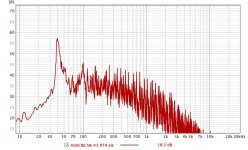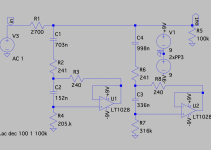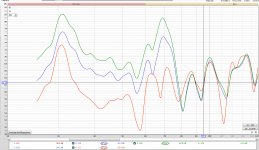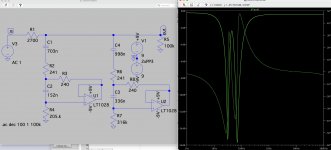Notch filters typically cause a lot of phase shift around the notch frequency. That can change the sound of bass in a way you may or may not like.
Also, notches don't exactly fix room modes. When a room exhibits a mode, it rings. Turning down the volume level of the ringing doesn't necessarily stop the ringing, it just makes it quieter.
First attempt at a fix should probably be to try moving the sub around the room to see if that helps. Using stereo subs can sometimes help too. If those things don't work, then construction of a bass trap may correct the problem better than a notch filter. The idea is to reproduce bass as it should be, with the bass frequency present but with its ringing damped in the time domain.
Also, notches don't exactly fix room modes. When a room exhibits a mode, it rings. Turning down the volume level of the ringing doesn't necessarily stop the ringing, it just makes it quieter.
First attempt at a fix should probably be to try moving the sub around the room to see if that helps. Using stereo subs can sometimes help too. If those things don't work, then construction of a bass trap may correct the problem better than a notch filter. The idea is to reproduce bass as it should be, with the bass frequency present but with its ringing damped in the time domain.
Notch filters typically cause a lot of phase shift around the notch frequency. That can change the sound of bass in a way you may or may not like.
Also, notches don't exactly fix room modes. When a room exhibits a mode, it rings. Turning down the volume level of the ringing doesn't necessarily stop the ringing, it just makes it quieter.
First attempt at a fix should probably be to try moving the sub around the room to see if that helps. Using stereo subs can sometimes help too. If those things don't work, then construction of a bass trap may correct the problem better than a notch filter. The idea is to reproduce bass as it should be, with the bass frequency present but with its ringing damped in the time domain.
Well the phase shift I guess is a challenge, can this be quantified?
the alternative is yeah sort the room, but moving or adding subs makes small differences but practically will not resolve things properly at 31 Hz according to REW room simulator.
also the assumption is a dsp is not as nice SQ as active filters
The green and significant peak is the subwoofer with the mains. all the others are just the mains.
Great to see that kind of more in-depth analysis. Now we can get started.
There are very great variations when you try moving the sub around. Once when we were redecorating the music room and it was fairly bare, I did 14 locations around the working end of the room.
So, I'd see what the "green" trace looks like in some different locations for the sub - including for test purposes weird off the wall spots.
I can't offer much help as to research design, but... If your sitting location is fixed, I'd keep the mic there. If your ensemble of speakers is fixed, I'd run tests with the full set.
I note once again that the acoustics DIYaudio forum is located far away from the sub forum, but I don't know why. This thread obviously belongs there (or in electronics) since it has no sub construction content. You don't want that do you? I think acoustics belongs among loudspeaker forums.
B.
Last edited:
the alternative is yeah sort the room, but moving or adding subs makes small differences but practically will not resolve things properly at 31 Hz according to REW room simulator.
REW may not simulate accurately in some cases. It isn't necessarily just the room dimensions that matter. For example, the location of floor support beams in wood frame building construction can affect sensitivity to vibration depending on relative source location. Sometimes moving a speaker half of an inch can make a meaningful difference. The only way to known for sure is to try it and see.
Fair enough.
I am getting microphone in the next couple of days.
Floors are suspended concrete with screed and glued on wooden flooring. Walls are hard plaster onto block.
Plus the Sub is errr...BIG so it can only go so many places.
Ceiling is plasterboard and it has a slope to match the flat roof fall (minimal but it exists) and worst thing is wall behind the listening position (sofa) is floor to ceiling glass.......
BUT it's a domestic space to a sub performing well.....that I have to sit on top of or place right in front of the woodburner is a no-no!
I am getting microphone in the next couple of days.
Floors are suspended concrete with screed and glued on wooden flooring. Walls are hard plaster onto block.
Plus the Sub is errr...BIG so it can only go so many places.
Ceiling is plasterboard and it has a slope to match the flat roof fall (minimal but it exists) and worst thing is wall behind the listening position (sofa) is floor to ceiling glass.......
BUT it's a domestic space to a sub performing well.....that I have to sit on top of or place right in front of the woodburner is a no-no!
Nothing personal, but that room may qualify for the Guinness Book of World Records. You need monumental acoustic re-thinking to address the 30 Hz issue (and some EQ to fix the big dip above that frequency). Trading the Klipsch would be a good move, eh.
In truth, movies and organ enthusiasts aside, there's not much on recordings below 40 Hz. Even the big orchestral side-drum doesn't need lower capability. And if you can live with occasional booms, life can go on. I'd focus on the dip 40-60.
BTW, you also have a rather severe - and very audible - boom at twice the room resonance near 65 Hz. Betcha that's what folks are hearing when music is playing because it can be quite awful (unlike 30 Hz which is pretty inaudible). That freq can be nicely handled with DSP or purpose-built filters.
Like MarkW4 says, test it.
B.
In truth, movies and organ enthusiasts aside, there's not much on recordings below 40 Hz. Even the big orchestral side-drum doesn't need lower capability. And if you can live with occasional booms, life can go on. I'd focus on the dip 40-60.
BTW, you also have a rather severe - and very audible - boom at twice the room resonance near 65 Hz. Betcha that's what folks are hearing when music is playing because it can be quite awful (unlike 30 Hz which is pretty inaudible). That freq can be nicely handled with DSP or purpose-built filters.
Like MarkW4 says, test it.
B.
Last edited:
ok - so I have made the notch filters as per the circuit here attached and the results are sort of inidfferent to frequency, just like turning the sub down...I am sure something must be amiss - any ideas.
Oh and the bass sound quality is like someone moved the bass to a house down the street made of cotton wool and left the window open......
The REW plots show
green my normal sub position with no filters connected.
blue with filters on with active circuit
red no sub at all.
seems like the R! 2K7 slugs the output and the circuit I have made somehow does nothing.......
any ideas?
Oh and the bass sound quality is like someone moved the bass to a house down the street made of cotton wool and left the window open......
The REW plots show
green my normal sub position with no filters connected.
blue with filters on with active circuit
red no sub at all.
seems like the R! 2K7 slugs the output and the circuit I have made somehow does nothing.......
any ideas?
Attachments
Not sure the circuit makes sense to my eyes.
Wouldn't it be a simple matter to plot the amp output with REW?
What does "no sub" red curve mean? Shouldn't there be no output down there?
And finally, for $150 you could simply buy a Behringer DCX2496 on eBay and fiddle for hours, dialling-in any notch you want.
B.
Wouldn't it be a simple matter to plot the amp output with REW?
What does "no sub" red curve mean? Shouldn't there be no output down there?
And finally, for $150 you could simply buy a Behringer DCX2496 on eBay and fiddle for hours, dialling-in any notch you want.
B.
I'd want some output there for reasons of diversity.What does "no sub" red curve mean? Shouldn't there be no output down there?
Sorry for any confusion
The circuit output plot is as attached and represents the filter performance as a notch.
The green red blue plots are REW with a microphone seeing what effect the notch filters have on the subwoofer, which is where they sit (in between the sub preamp and power amp)
The red is the sub turned off, the green is turned on and my normal chosen position based on listening; the blue is the amp turned on with the active filter in place.
The circuit output plot is as attached and represents the filter performance as a notch.
The green red blue plots are REW with a microphone seeing what effect the notch filters have on the subwoofer, which is where they sit (in between the sub preamp and power amp)
The red is the sub turned off, the green is turned on and my normal chosen position based on listening; the blue is the amp turned on with the active filter in place.
Attachments
- Home
- Loudspeakers
- Subwoofers
- Notch Filters to remove room modes



